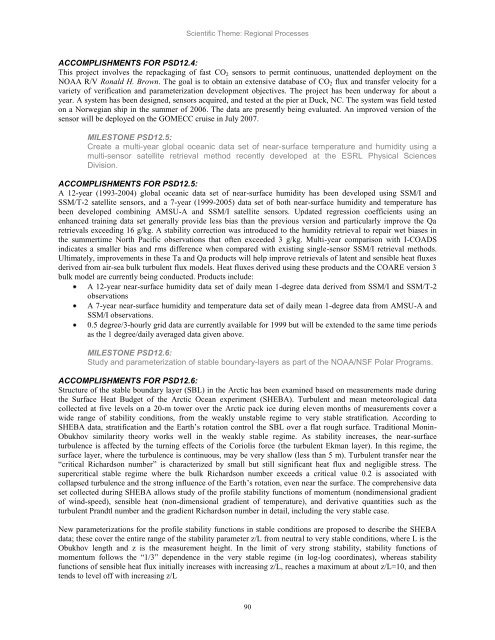Scientific Theme: Advanced Modeling and Observing Systems
Scientific Theme: Advanced Modeling and Observing Systems
Scientific Theme: Advanced Modeling and Observing Systems
Create successful ePaper yourself
Turn your PDF publications into a flip-book with our unique Google optimized e-Paper software.
<strong>Scientific</strong> <strong>Theme</strong>: Regional Processes<br />
ACCOMPLISHMENTS FOR PSD12.4:<br />
This project involves the repackaging of fast CO2 sensors to permit continuous, unattended deployment on the<br />
NOAA R/V Ronald H. Brown. The goal is to obtain an extensive database of CO2 flux <strong>and</strong> transfer velocity for a<br />
variety of verification <strong>and</strong> parameterization development objectives. The project has been underway for about a<br />
year. A system has been designed, sensors acquired, <strong>and</strong> tested at the pier at Duck, NC. The system was field tested<br />
on a Norwegian ship in the summer of 2006. The data are presently being evaluated. An improved version of the<br />
sensor will be deployed on the GOMECC cruise in July 2007.<br />
MILESTONE PSD12.5:<br />
Create a multi-year global oceanic data set of near-surface temperature <strong>and</strong> humidity using a<br />
multi-sensor satellite retrieval method recently developed at the ESRL Physical Sciences<br />
Division.<br />
ACCOMPLISHMENTS FOR PSD12.5:<br />
A 12-year (1993-2004) global oceanic data set of near-surface humidity has been developed using SSM/I <strong>and</strong><br />
SSM/T-2 satellite sensors, <strong>and</strong> a 7-year (1999-2005) data set of both near-surface humidity <strong>and</strong> temperature has<br />
been developed combining AMSU-A <strong>and</strong> SSM/I satellite sensors. Updated regression coefficients using an<br />
enhanced training data set generally provide less bias than the previous version <strong>and</strong> particularly improve the Qa<br />
retrievals exceeding 16 g/kg. A stability correction was introduced to the humidity retrieval to repair wet biases in<br />
the summertime North Pacific observations that often exceeded 3 g/kg. Multi-year comparison with I-COADS<br />
indicates a smaller bias <strong>and</strong> rms difference when compared with existing single-sensor SSM/I retrieval methods.<br />
Ultimately, improvements in these Ta <strong>and</strong> Qa products will help improve retrievals of latent <strong>and</strong> sensible heat fluxes<br />
derived from air-sea bulk turbulent flux models. Heat fluxes derived using these products <strong>and</strong> the COARE version 3<br />
bulk model are currently being conducted. Products include:<br />
A 12-year near-surface humidity data set of daily mean 1-degree data derived from SSM/I <strong>and</strong> SSM/T-2<br />
observations<br />
A 7-year near-surface humidity <strong>and</strong> temperature data set of daily mean 1-degree data from AMSU-A <strong>and</strong><br />
SSM/I observations.<br />
0.5 degree/3-hourly grid data are currently available for 1999 but will be extended to the same time periods<br />
as the 1 degree/daily averaged data given above.<br />
MILESTONE PSD12.6:<br />
Study <strong>and</strong> parameterization of stable boundary-layers as part of the NOAA/NSF Polar Programs.<br />
ACCOMPLISHMENTS FOR PSD12.6:<br />
Structure of the stable boundary layer (SBL) in the Arctic has been examined based on measurements made during<br />
the Surface Heat Budget of the Arctic Ocean experiment (SHEBA). Turbulent <strong>and</strong> mean meteorological data<br />
collected at five levels on a 20-m tower over the Arctic pack ice during eleven months of measurements cover a<br />
wide range of stability conditions, from the weakly unstable regime to very stable stratification. According to<br />
SHEBA data, stratification <strong>and</strong> the Earth‘s rotation control the SBL over a flat rough surface. Traditional Monin-<br />
Obukhov similarity theory works well in the weakly stable regime. As stability increases, the near-surface<br />
turbulence is affected by the turning effects of the Coriolis force (the turbulent Ekman layer). In this regime, the<br />
surface layer, where the turbulence is continuous, may be very shallow (less than 5 m). Turbulent transfer near the<br />
―critical Richardson number‖ is characterized by small but still significant heat flux <strong>and</strong> negligible stress. The<br />
supercritical stable regime where the bulk Richardson number exceeds a critical value 0.2 is associated with<br />
collapsed turbulence <strong>and</strong> the strong influence of the Earth‘s rotation, even near the surface. The comprehensive data<br />
set collected during SHEBA allows study of the profile stability functions of momentum (nondimensional gradient<br />
of wind-speed), sensible heat (non-dimensional gradient of temperature), <strong>and</strong> derivative quantities such as the<br />
turbulent Pr<strong>and</strong>tl number <strong>and</strong> the gradient Richardson number in detail, including the very stable case.<br />
New parameterizations for the profile stability functions in stable conditions are proposed to describe the SHEBA<br />
data; these cover the entire range of the stability parameter z/L from neutral to very stable conditions, where L is the<br />
Obukhov length <strong>and</strong> z is the measurement height. In the limit of very strong stability, stability functions of<br />
momentum follows the ―1/3‖ dependence in the very stable regime (in log-log coordinates), whereas stability<br />
functions of sensible heat flux initially increases with increasing z/L, reaches a maximum at about z/L=10, <strong>and</strong> then<br />
tends to level off with increasing z/L<br />
90
















